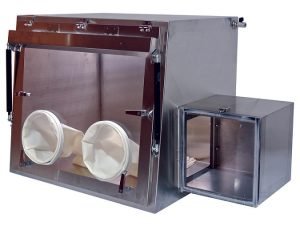A glove box, also known as an isolation glove box or a containment glove box, is a vital piece of equipment in laboratory settings. It provides a controlled environment that isolates the user’s hands and materials inside from the external atmosphere. This controlled atmosphere serves various purposes, making glove boxes indispensable in a wide range of laboratory applications. In this comprehensive guide, we will delve into what a glove box is, its design and components, and its diverse applications in laboratories.
Understanding the Glove Box

A glove box is essentially a sealed container with built-in gloves that allow operators to manipulate objects and perform tasks inside the box without exposing the contents to the surrounding environment. This controlled environment is typically achieved by maintaining specific levels of humidity, temperature, and gas composition inside the glove box.
Components of a Glove Box
Chamber: The primary structure of a glove box is the chamber itself, which is usually made from materials like acrylic, stainless steel, or glass. The chamber is transparent to allow operators to see and work with the contents inside.
Gloves: Integrated gloves are the most distinguishing feature of a glove box. These gloves are attached to sealed ports on the front of the chamber, allowing users to insert their hands and manipulate objects while maintaining a sealed environment.
Gas Purification System: To control the atmosphere inside the glove box, a gas purification system is often integrated. This system can remove moisture, oxygen, and other contaminants, ensuring a clean and controlled environment.
Pressure Control: Maintaining a stable pressure inside the glove box is crucial. Pressure control systems help prevent the escape of gases and contaminants while ensuring the safety of the operator.
Airlock and Pass-Through Ports: These features enable the introduction and removal of materials without compromising the internal atmosphere. Airlocks are especially useful for transferring samples and equipment in and out of the glove box.
Lighting and Viewing Window: Adequate lighting and a viewing window allow operators to clearly see and work with the materials inside the glove box.
Applications of Glove Boxes in Laboratories

Chemical Research and Analysis:
Glove boxes are widely used in chemistry laboratories to handle sensitive and reactive substances. They provide a controlled environment that prevents moisture and oxygen from contaminating or reacting with chemicals. This is essential for experiments involving air-sensitive compounds, such as organometallic reactions and catalyst synthesis.
Pharmaceutical Research:
In pharmaceutical laboratories, glove boxes play a crucial role in drug development and manufacturing. They are used for tasks like weighing and blending powders, handling active pharmaceutical ingredients (APIs), and preparing samples for analysis. Containment glove boxes are especially important when dealing with potent drugs that require protection against exposure.
Electronics and Semiconductor Manufacturing:
Semiconductor fabrication processes demand high levels of cleanliness and precision. Glove boxes are used in cleanrooms to assemble and handle sensitive electronic components, ensuring they are free from contamination and moisture that could affect device performance.
Nanotechnology Research:
Researchers in nanotechnology laboratories use glove boxes to manipulate nanomaterials and Nano devices. The controlled environment prevents contamination and allows for precise experimentation at the nanoscale.
Biology and Microbiology:
Glove boxes are used in biological research for working with microorganisms, cell cultures, and biohazardous materials. They provide a barrier between researchers and potentially harmful biological agents, enhancing safety.
Materials Science:
In materials science laboratories, glove boxes are utilized to handle air-sensitive materials, create controlled atmospheres for experiments, and assemble specialized equipment.
Aerospace and Defense:
Research and development in aerospace and defense industries often involve the use of explosive or reactive materials. Glove boxes are employed to safely handle these substances during testing and prototyping.
Environmental Testing:
Laboratories conducting environmental analysis, such as water quality testing, may use glove boxes to ensure that samples are not contaminated during preparation and analysis.
Benefits of Using a Glove Box in Laboratories
Operator Safety:
One of the primary advantages of glove boxes is the protection they offer to laboratory personnel. Operators can work with hazardous materials without direct exposure, reducing the risk of accidents and chemical exposure.
Sample Integrity:
Glove boxes help maintain the purity and integrity of samples and materials by preventing contamination from moisture, oxygen, and airborne impurities.
Precision and Control:
Researchers can precisely control the environment inside the glove box, including temperature, humidity, and gas composition. This control is essential for conducting accurate experiments and maintaining the stability of sensitive materials.
Product Quality in Manufacturing:
In manufacturing settings, glove boxes ensure the quality of products by preventing contamination during assembly and handling processes. This is critical in industries like pharmaceuticals and electronics.
Versatility:
Glove boxes are versatile and can be customized to suit specific laboratory needs. They can be integrated with additional features such as antechambers, HEPA filters, and specialized gas systems.
Regulatory Compliance:
Laboratories that handle hazardous materials are often subject to strict safety and environmental regulations. Glove boxes help laboratories comply with these regulations by providing a controlled environment for handling dangerous substances.
Maintenance and Best Practices
To ensure the effectiveness and longevity of a glove box, laboratories should adhere to proper maintenance practices:
Regular Cleaning: Clean the interior of the glove box regularly to prevent the buildup of contaminants. Use appropriate cleaning agents and follow the manufacturer’s guidelines.
Glove Replacement: Replace the gloves when they show signs of wear or damage to maintain the integrity of the containment barrier.
Gas Purification: Monitor and maintain the gas purification system to ensure the purity of the internal atmosphere.
Pressure Control: Calibrate and maintain the pressure control system to prevent leaks and maintain a stable environment.
User Training: Properly train laboratory personnel in the use of glove boxes, including safety protocols and emergency procedures.
Conclusion
Glove boxes are indispensable tools in laboratory settings, offering a controlled environment for a wide range of applications. Their ability to protect both laboratory personnel and sensitive materials makes them essential in fields ranging from chemistry to nanotechnology. By understanding the components, applications, and benefits of glove boxes, laboratories can optimize their operations, enhance safety, and maintain the integrity of their research and manufacturing processes. Cleatech LLC is a trusted provider of high-quality glove boxes, offering a variety of models to meet the diverse needs of laboratories across industries. Investing in a reliable glove box can significantly improve laboratory efficiency and safety while ensuring the success of critical experiments and processes.










